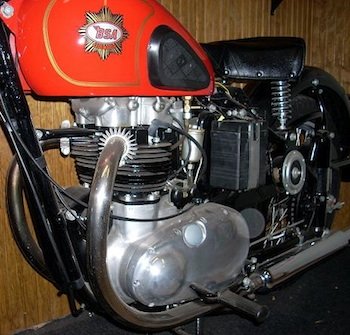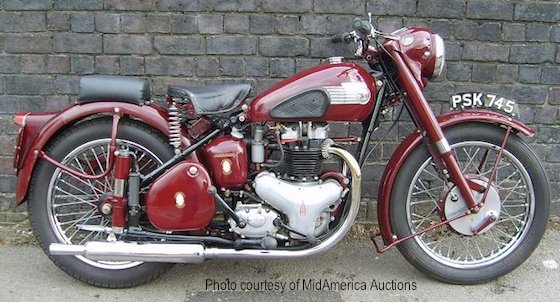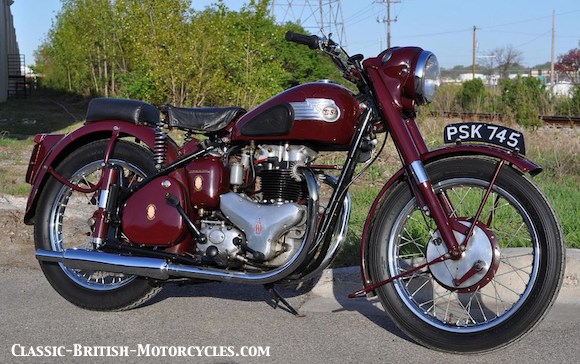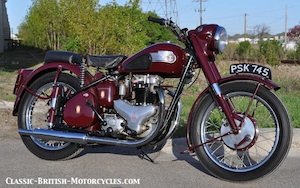ABOVE: This 1952 BSA A7 featured plunger rear suspension, the transition between earlier rigid frames & the swing arm frames to arrive in 1954.
BIRTH OF THE BSA A7
By the onset of World War II, BSA was one of, if not THE largest motorcycle manufacturers in the world. They were making great success of their line of singles, lead by the BSA Gold Star. They’d done a few V-twins in the past, primarily for sidecar duty, but their business was singles & no one was better at it than BSA.
INSPIRED BY THE SPEED TWIN
Like every other British motorcycle company at the time, BSA Motorcycles wanted into the vertical twin business, once Triumph had launched their seminal 500cc Speed Twin in 1938. They wasted no time & jumped right in with their own Val Page design. But alas, history intervened, World War II started & all production was diverted to wartime purposes. But, as soon as the war ended, BSA resumed work in earnest. The design & basic architecture was contributed to by not only Val Page (JAP, Ariel & Triumph), but by Joe Craig (Norton & AMC), Herbert Perkins, David Munro & even Edward Turner himself (Ariel & Triumph). Numerous prototypes were built between 1938 & 1945 before production was reached.
ENGINE DESIGN
What emerged was a vertical twin cylinder engine with cast iron cylinders & head, a vertically-split aluminum crankcase, with the cam behind the cylinder block. The pushrods passed through an integral tunnel inside the cylinder block casting, to the rocker box. The crank pins were arranged inline (360-degrees) providing for one power stroke for every engine revolution. The bore & stroke were 62mm X 82mm for a displacement of 495cc. It was considered by many to be the quintessential British vertical twin of the era. It produced 26hp at 6000rpm.
INTERNALS
The crankshaft was pressed together out of 3 parts with plain big end bearings & one-piece connecting rods. The silicone alloy pistons were flat-topped with a compression ratio of 7.0:1, to accommodate low octane ‘pool’ petrol available the Brits at the time.
CYLINDER HEAD
BSA called their new cylinder head ‘monobloc’, designed to provide excellent air flow over, under, around & through all the hot parts, with large openings between the cylinders & under the rocker boxes. The widely-splayed exhaust ports & the rear pushrod tunnel aided in this.
A7 MARK 1
This first version of the BSA A7 500 twin was called the A7 Mark 1 & it ran from 1946 through the 1950 model year, when replaced in the 1951 model year by, you guessed it, the BSA A7 Mark 2.

SEMI-UNIT CONSTRUCTION
The custom at the time was to assemble the separate crankcase, primary case & gear box (all separate components) with heavy mounting plates, with slotted bolt holes that allowed the gearbox to be rotated in its mounts, as a means of adjusting the primary chain. This was crude & inconvenient (the final drive chain needed to be adjusted after the primary chain), was heavy & inherently weak. The BSA A7 featured a new design, dubbed ‘semi-unit’. Here the crankcase & the gearbox were solidly mounted to one another, with the gearbox in a fixed position. Now primary chain adjustment was accomplished with a slipper-type tensioner inside the primary chain case. This not only made chain adjustment much easier, but also made for a much more rigid engine/gearbox structure, almost on par with ‘unit construction’ types. That gearbox was an all-new 4-speed foot-shift box that was lighter, more compact & smoother shifting than the units BSA was using on their singles.
FRAME & RUNNING GEAR
This new engine was placed into a new frame, specific to the twin. It was a rigid frame of brazed lug construction, with two front downtubes & full cradle construction. The new telescopic front forks were taken directly from the BSA Singles’ parts bin, as were the front & rear brakes, both 7-inch SLS. Overall, it was a good-looking, well-put-together machine that offered decent performance & class-leading reliability & smoothness.
NOT THE FASTEST, JUST THE QUIETEST
BSA quickly garnered a reputation for building machines that weren’t quite as fast as the Triumph twins, but were more oil-tight & quieter. They achieved this quietness through robust design & then-unique features like the semi-unitized crankcase & gearbox, a single cam (instead of 2 like the Triumph), timing gears (instead of chains like Ariel & Royal Enfield) & inner & outer timing cases. This reputation served BSA Motorcycles well, over the years.

PLUNGER REAR SUSPENSION
The first ‘plunger’ frames appeared at the Earls Court Motorcycle Show in 1948 & were first used in production on the top-of-the-line 1949 BSA 500 Star Twin. The plunger frame would spread to the entire 500 twin lineup for the 1950 model year. While the plunger was a big improvement over the antiquated rigid frame, it did offer some suspension travel, it was at best a poor compromise. Plungers were widely used by many manufacturers at the time, for the same reason that BSA chose it. It allowed them to continue to use their old rigid frames (with a few mods), rather than ditching them for an entirely new swingarm frame.
BSA A7 MARK 2
For the 1951 model year, BSA Motorcycles brought out a revised engine. Now the bore & stroke were 66mm X 72.6mm for 497cc of displacement. They were 62mm X 82mm for 495cc). Being less undersquare, the engine was more willing to rev & picked up some smoothness. The bigger bore meant shallower combustion chambers, which in turn meant a narrower valve angle, the same as the 650 BSA A10. Compression ratios rose to 6.7:1 with an option of 7.2:1. Fuel quality in Britain was improving.
OTHER IMPROVEMENTS
The BSA A7 was now sharing more parts with its big brother, the A10 including the crankshaft, the crankcase & a new alloy head. The new crank was a one-piece forged design with a bolted-on central flywheel.

SWING ARM FRAME ARRIVES
An all-new swing arm frame was introduced in 1954, along with an all-new roadster line, the BSA Shooting Star with an all-new alloy cylinder head. All 1954 BSA Shooting Stars had the new frame. The standard BSA A7 was now offered with either plunger or swingarm rear suspension; while all BSA Star Twins came with the plunger. When the Star Twin was dropped in 1955, this left the standard A7 as the only model still offering the plunger frame.
FEW CHANGES
New wheel hubs arrived in 1958. These were cast iron, full-width hubs with flanges to permit the use of straight-pull chrome-plated spokes. The standard BSA A7 got 7-inch hubs front & rear & the higher-performance Shoot Star (as well as all the 650 A10’s) got an 8-inch front unit. Since the A7 weighed pretty much the same as the A10 & certainly the Shooting Star, this left it well under-braked, considering its performance.
THE END OF THE LINE
Minor detail changes continued, but few significant changes were made in these final years of A7 production, as the Small Heath factory concentrated on finishing up the new bike that would replace it: the BSA 500 A50 & the BSA 650 A10. These new unit-construction engines, while well-engineered, never sold as well or garnered the kind of respect and owner loyalty that BSA had become accustomed to with its wonderful pre-unit machines. It must have been quite a blow to take such a major technological step forward only to take a huge step backward in sales & market share. The switch to unit construction in 1962 either coincided with, or actually spelled the end of BSA as a major player in the motorcycle market. The following year, 1963, BSA dropped its legendary 500 Gold Star from the lineup, attempting to replace it with another unit-construction job, the 441 Victor. It too did poorly in the market, when compared to the model it replaced.
THE END OF AN AGE
BSA was on top of the world in the 1950s, having emerged from WWII as the preeminent motorcycle maker. Their singles dominated the marketplace & the racetrack & their twins earned a reputation of solid construction & good performance & again, this spread to the showroom. But times & tastes were changing & alas, BSA was not.
BSA A7 YEAR-BY-YEAR
BSA’s pre-unit 500 twin used a plunger-style rear suspension. It allowed them to only slightly modify their rigid frame.
BSA’s pre-unit 500 twin thunders on through the 50s, with continuous improvements. It now had a full swing arm rear suspension, greatly improving ride & handling.
Check out these BSA BOOKS
BSA Motorcycles: The Final Evolution
The BSA Gold Star: Motorcycle History
Illustrated Bsa Buyer’s Guide (Motorbooks International Illustrated Buyer’s Guide)
BSA Unit Singles: The Complete Story including the Triumph Derivatives
Bsa Motor Cycles: Since 1950 (British Motor cycles since 1950)
BSA 500 & 650 Twins: The Essential Buyer’s Guide
How to Restore Triumph Trident T150/T160 & BSA Rocket III: YOUR step-by-step colour illustrated guide to complete restoration (Enthusiast’s Restoration Manual)















No Comment